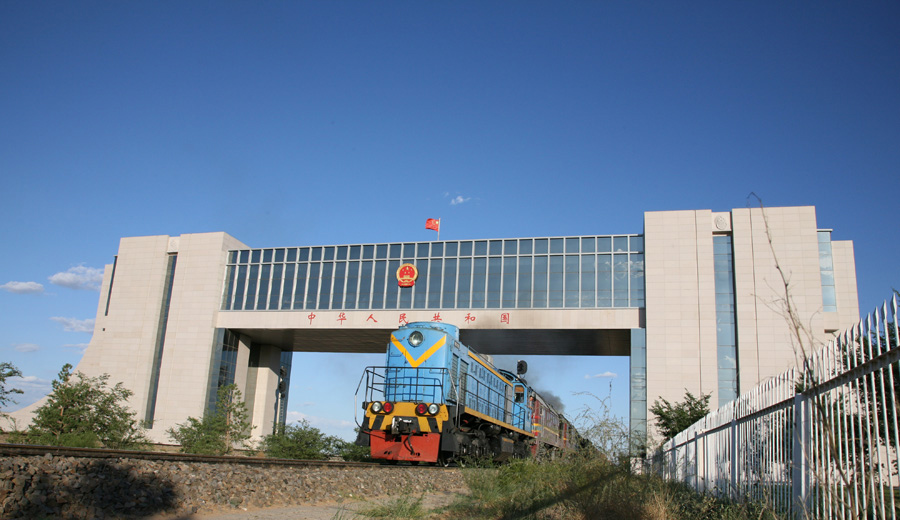Inner Mongolia achieved rapid development in last 70 years

A cargo train in Erenhot, a railway port of Inner Mongolia, leaves for Mongolia. The rapid progress in the city exemplifies the historic breakthrough of economic development in Inner Mongolia.
May 1 marked the 70th anniversary of the establishment of the Inner Mongolia Autonomous Region, the first provincial autonomous region among China’s ethnic minority areas. The past seven decades have witnessed its comprehensive development in politics, economy, culture and social affairs.
Hao Shiyuan, a Member of the Chinese Academy of Social Sciences, said, “Inner Mongolia was a pioneer in the establishment of regional national autonomy, one of China’s fundamental political systems. Its progress during the past 70 years has proven the success of the approach to solving ethnic problems.”
In its infancy, Inner Mongolia implemented the policy of “no struggle with herd owners, no distribution of livestock of herd owners, no class identification, and benefits for both herd owners and herdsmen.” This guaranteed steady economic development.
During socialist transformation in the 1950s, it proposed innovative guidelines for the transformation of animal husbandry and adopted ethnic-oriented policies for agriculture. Agricultural cooperatives comprising one or more ethnic minorities were established. Production was thus advanced in a stable environment.
After reform and opening up, Inner Mongolia was the first autonomous region to implement the Livestock and Grassland Double-Contract Responsibility System, ensure grassland ownership, and exempt agriculture and animal husbandry from taxation. Li Jing, a professor of the School of Marxism from the Inner Mongolia University of Finance and Economics, said, “Inner Mongolia has gained much experience in line with ethnic and regional realities by implementing the regional ethnic autonomy policy flexibly.”
Erenhot, a small city bordering China and Mongolia, has become an important railway port. From 1956 to 1988, its freight volume totaled 30 million tons. In 2016, it reached a record 9.83 million tons.
The rapid progress in the city exemplifies the historic breakthrough of economic development in Inner Mongolia. Taking advantage of the western development drive, it made full use of its rich resources to develop energy and heavy chemical industry. For eight consecutive years from 2002 to 2009, Inner Mongolia boasted the fastest economic growth in China.
Its GDP ranking among China’s 31 provinces, municipalities and autonomous regions, excluding Hong Kong, Macao and Taiwan, grew from 24th in 2000 to 15th in 2010.
After the 18th National Congress, the Chinese economy entered a “new normal” characterized by slowdown in growth rate, structural optimization and shift of driving forces. Inner Mongolia adjusted accordingly, leading to further progress.
Industrial parks featuring cloud computing and Big Data have sprung up in such cities as Hohhot, Baotou, Erdos, Ulanqab, and Chifeng. Its current total capacity of 700,000 servers makes Inner Mongolia the pacesetter in this field, attracting many market leaders to establish data centers here. Data mining has replaced coal digging. The Big Data industry is driving the industrial upgrading effort.
Extending along the northern border, Inner Mongolia is also vital to national eco-security. In 2016, overall energy consumption of industrial enterprises above a designated size only increased by 0.9 percent, and that of the seven most energy-intensive industries merely rose by 0.8 percent.
Zhao Haidong, a professor of the School of Economics and Management from Inner Mongolia University, said the value added by the tertiary industry in 2016 accounted for 42.5 percent of the region’s total GDP, driving 47.2 percent of economic growth. The tertiary industry is growing fast, boosting economic quality and efficiency while supporting steady transformation.
“Prioritizing economic and social development has been vital to growth in Inner Mongolia during the past 70 years,” Li said.
Mao Li is a reporter at the Chinese Social Sciences Today.

 PRINT
PRINT CLOSE
CLOSE